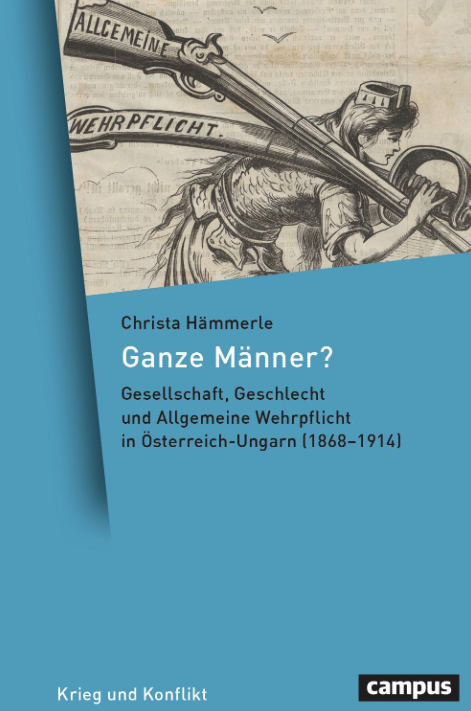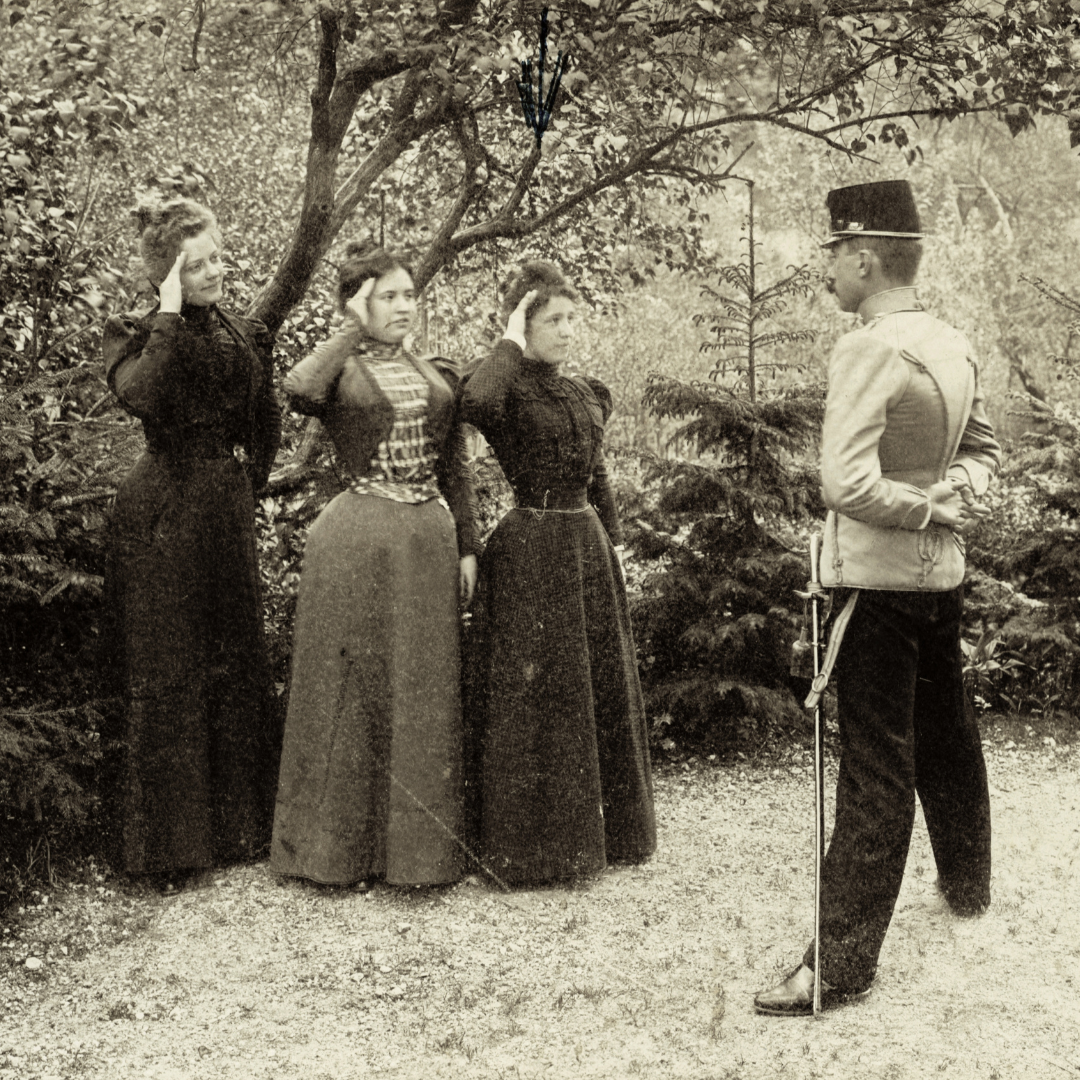The societal impact of universal conscription in Austria-Hungary

Published by: Campus Verlag

Ganze Männer? – this question is the title of Christa Hämmerle’s new book on universal conscription (Allgemeine Wehrpflicht) in Austria-Hungary and its impact on society and gender (conceptions) in the Habsburg Monarchy between 1868 and 1914.
In her book, Hämmerle explores a wide set of themes. The book raises questions, for example, about the effects and the “societal meanings and functions of universal conscription” (p. 17). Hämmerle also analyzes what military service intended to teach these men. This interest is linked to the question of what ideal images were designed for the recruits and the rank and file (Mannschaftssoldaten) and how the multiethnicity of the state and concepts of masculinity were integrated into these images. Furthermore, she examines how the implementation and enforcement of universal conscription unfolded in practice.
Hämmerle approaches the topic in three main themes: “Regulating Military Service: Laws and Law Controversies”; “Interpreting Military Service: Images of Men in Motion”; and “Experiencing Military Service: Practices and Memories”. She clearly defines the framework conditions and limitations of her study. For example, the focus of the study is on the Imperial (and) Royal (k. (u.) k.) Army and on the implementation and enforcement of universal conscription in Cisleithania. These frameworks can be explained against the background of the programmatic approach of the study – such as unfolding “micro-historical perspectives” (p. 16). Furthermore, Hämmerle specifically analyses German-language sources in depth from social, political, and military contexts and gives women and the rank and file a chance to be heard too.
The first part of the book, “Regulating Military Service”, deals with the legal dimensions and the emerging controversies surrounding the introduction of the universal conscription and its further development until the eve of the First World War. Hämmerle shows that the universal conscription was implemented in 1868 because of the military defeat in the Austro-Prussian War in 1866 and under the pressure of a scenario of an outside threat – the “European predicament” (“europäische Zwangslage”) (p. 75) as it was expressed at the time. Based on the development of the universal conscription – with its caesuras in 1889 and 1912, when new conscription laws were introduced, as examined in the book – and on the laws, that accompanied universal conscription, she shows that even in the multi-ethnic Habsburg Monarchy there was a “triumphal march” (p. 201) of the recruitment system. The result was a “legal militarization” (“legistische Militarisierung”) (p. 17 and p. 51) and an increasing entanglement between the military and civil society. This occurred despite critical voices from various political and social milieus, including women as well as from within the military, who warned of future consequences of increasing militarism – always legitimized by the evoked scenario of a threat from the other European powers.
These discourses touched on the question of what the ideal image of soldiers, their character traits and virtues should be: for example, disciplined, toughened, strong-nerved, intelligent, with a moral spirit and a sense of duty and honor. Or to put it in other words: a “real man”.
The second chapter, “Interpreting Military Service”, focuses on the formulation of ideal images of recruits and the rank and file with reference to existing military discourses in German language. It becomes clear that these discourses were characterized by ambivalence: “Drill or Education” (pp. 208-209) was one of the central issues regarding the training of the soldiers, which related to traditional or “modern or future-oriented views” (p. 313). In contrast, there was agreement not only on the dynastic orientation of the army and the integrative as well as educational function of military service – although this was associated with ethnic-cultural stereotyping – but also in the rejection of democratization tendencies. These discourses touched on the question of what the ideal image of soldiers, their character traits and virtues should be: for example, disciplined, toughened, strong-nerved, intelligent, with a moral spirit and a sense of duty and honor. Or to put it in other words: a “real man”. However, to what extent the military succeeded in pushing its ideal of masculinity onto society had to remain open to a certain degree (pp. 315-318).
The third part of the book, “Experiencing Military Service”, takes up the “implementation, enforcement and social acceptance” (p. 319) as well as the experience of universal conscription and military service. Through letters, ego-documents, and military court records, among other sources, a view at the preparing and conducting the draft in the local communities, the physical examination, and the life in barracks unfolds. It becomes clear that verifying whether someone was obligated to serve, and thus fit for service, was a complex undertaking – not only for the recruits themselves, but also for the military officials and the local authorities. The study also shows that there was ambivalence in the acceptance of the influence of the state and the military on society. Following this, the chapter then illustrates the experiences that accompanied recruit life: the drill, being disciplined, but also the language diversity and multi-ethnicity. Moreover, the time as a recruit is demonstrated to have been a caesura. A moment of upheaval and – at least theoretically – equalization: also, as regards the identity of masculinity. The civilian man was dissolved – and became a feminized man (p. 423) in the military sense. Masculinity had to be relearned and earned anew.
The book ends with an outlook on the period after 1914. Therein, Hämmerle combines her research findings with the preliminary climax and ultimate test of the developments that universal conscription brought with it on a legal, social, and military level: the First World War and the accompanying consequences for society, women, children, and men. It becomes clear that the history of the universal conscription and its impact on politics, military, and society until 1914 is also a part of the “prehistory” of the terror, violence, and catastrophe of the First World War.
In sum, Hämmerle’s book not only shows the impact which the introduction and evolution of universal conscription had on these conscripted men, but also on women, families, politics, military, society, and gender (conceptions) in the Habsburg Monarchy. In addition, Hämmerle uses a meticulously researched and critically examined source base to show how the soldiers experienced and perceived their military service – which also enables her to tell an “actor-centered” story and a story “from below” (p. 320). A story that deliberately avoids an exclusive focus on officer narratives and instead takes up the accounts of the rank and file. Last but not least, the book points out where research desiderata still exist: for example, regarding the question of how universal conscription in Austria-Hungary was perceived by other non-German voices and what this meant for a shared imperial consciousness (pp. 527-528). Moreover, in the context of the analysis of sexual violence committed by these men against women and against men (pp. 489-490) and how this might be linked to militarized masculinity. These are tasks that new studies could and should take on and for which Hämmerle’s book has provided new perspectives.
Tobias Neubauer is a doctoral student at the University of Oldenburg. His dissertation project focuses on acts of violence committed by the Austro-Hungarian military against the civilian population during the First World War, with a special emphasis on the Eastern Front.
